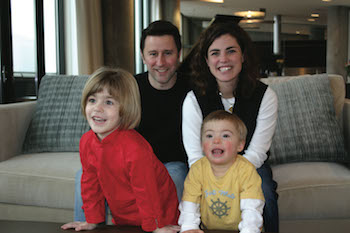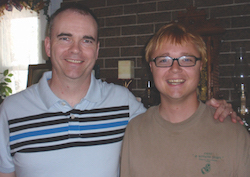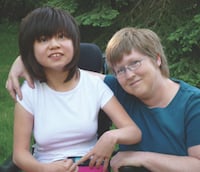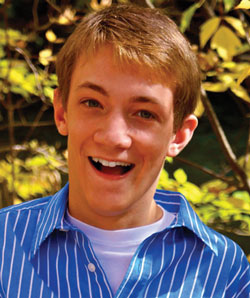Personal Stories
The Invisible Safety Net
2006

You can’t see it, but it’s there. You hear it in the friendly phone call from your neighbor. You feel it in your aunt’s offer to babysit. You sense it when you are inspired by another parent of a child with a disability.
Individually, each of those encounters may seem like just a pleasant moment. Together, however, they form something important, even essential for families of children with disabilities. Such connections become an informal support network that provides encouragement, strength, information, and practical help. Whether you seek it out or it just unfolds, such a network can make a world of difference in your family’s daily life. How you create those connections is as individual as you are.
Two years ago, Jessica Broyles found herself dealing with an unexpected turn of events. She went into labor 6 ½ weeks early, then was told that her newborn, Sam, had Down syndrome. With 21-month-old Maggie at home, she and her husband were faced with keeping the family on an even keel while adjusting to life with a child with a disability.
“The first month, when Sam was still in the hospital, we didn’t go beyond family for support,” Jessica says, noting that her parents, mother-in-law, brother, and sister were nearby. “They helped tons. They always stopped by, so we didn’t become isolated.
“We learned about PACER Center right away,” Jessica says. “John Hoffman, PACER’s early childhood coordinator, gave us an overview of early childhood special education and sent us useful advice on everything from setting up an Individual Family Service Plan (IFSP) to working with doctors. PACER has been an invaluable resource in helping us to set expectations and understand Sam’s educational rights.”
The circle soon expanded to include Sam’s pediatrician, who provides both practical and emotional support. Then it encompassed physical, speech, and occupational therapists. “They take a genuine interest in Sam,” Jessica says. She notes that they share lots of encouraging stories about other children who have Down syndrome and talk about possibilities for the future. “They are so positive about everything,” Jessica says.
Eventually, friends and other families of children with disabilities became part of their world. The family was surprised and delighted when two aunts joined in enthusiastically. “They totally zeroed in on Sam and are so attached to him,” Jessica says, noting that they are always eager to baby-sit.
Other families have found different ways to build their networks. Some without relatives in town have turned to disability-specific organizations or to support groups where they can meet others in a similar situation. As connections develop, occasional phone calls or weekly e-mails become supportive touches as parents share observations about their children’s milestones and challenges.
For many families, PACER Center becomes a major support. Through workshops, consultations with advocates, written materials, and more, parents receive the information and tools they need to advocate for their child.
Parents agree that when you have a child with a disability, it’s a different world and culture.
Whatever your needs, it can be a world rich with support, says PACER’s Hoffman. Just look around to the family, friends, neighbors, doctors, therapists, support groups, and organizations that surround you, and you can build a network that suits your style.
Siblings Forever
2009
Any parent will tell you, raising a child isn’t easy—and raising more than one is additionally complex. If one of the children also has a disability, it can create a unique set of challenges for parents and siblings alike.
Two PACER staff members — Sean Roy and Kim Kang — share their different perspectives on what impact a child with a disability can have on a family. Sean is project director for transition and workforce development and grew up with a brother on the autism spectrum. Kim is PACER’s public policy director and early childhood coordinator and the mother of two teens, one with traumatic brain injury.
A Brother’s View

Sean was 8 when his brother, Andrew, was born. Everything seemed fine at first, but within a year the family became concerned that Andrew wasn’t progressing and meeting milestones. When he was 2, he was assessed and diagnosed with autism. “Andrew wasn’t talking, and he was really acting out,” Sean says, recalling those early days. “His behaviors became challenging at times. He would strip all the new wallpaper off his bedroom wall, for example, and it was hard to take him out in public. He would have tantrums, especially if he didn’t want to leave somewhere.”
It was 1981 in small-town Minnesota. Schools weren’t well equipped to address the needs of children with autism or their families. “The school in our town didn’t have a program for Andrew, so the district paid to transport him 40 miles each way,” Sean says, noting that Andrew began receiving early intervention services when he was 3.
While the family had to make adjustments, “there certainly wasn’t a big hubbub about Andy,” Sean recalls. “We did what we had to do. He was just my brother. He didn’t draw attention away from me. I was aware that he had a disability, but our whole life did not revolve around it.
“I’d play sports and have one parent there and the other home with Andrew—but I didn’t care. My childhood wasn’t defined by him. He was very much a part of it. I didn’t feel like an only child. We always had brotherly experiences. I taught him how to ride a bike, play video games, swing a bat.”
Being in a small town was, in some ways, an advantage. People were accepting of difference. “There were never any instances where he was a barrier or an embarrassment,” Sean says. “I don’t think that’s as atypical as people may think. A lot of it has to do with how the family reacts to the disability. It was just, ‘okay, this is what we have to do, let’s move on.’”
For Sean, the experience was positive. “I think it probably gave me an increased level of responsibility in the family,” he says, adding, “having a sibling with a disability is character building. You learn humility and acceptance, and you learn to view people in an inclusive way. That’s an experience that shouldn’t be ignored.”
In Sean’s case, it became an impetus to a career path. “It gave me a perspective into people with disabilities and the systems that are in place to support them in the community. I see what I do at PACER as a way to blend a life expertise and a desire to be in a helping profession.
“It’s important – the point I made about never feeling shortchanged,” he adds. “Andrew has grown up to be a very well-spoken and fun young man and a fantastic uncle to my children. He plays golf and intramural sports. It’s been amazing to watch him blossom.”
A Parent’s Perspective

Fourteen years ago, Kim and her husband welcomed their second daughter, Rachel, into their family and looked forward to watching her and 3-year-old Chelsea grow up together. Six months later, Kim received a phone call from a hospital saying Rachel was in the emergency room, the victim of shaken baby syndrome while at her day-care provider.
As a result of the abuse, she suffered cortical visual impairment and developed both a seizure disorder and cerebral palsy. She is in a wheelchair and has the cognitive level of a 2- or 3-year-old.
“I had no frame of reference for what disability looks like,” Kim says, remembering that traumatic time. “When I grew up, my school had a separate building for children with disabilities.”
Suddenly having a child with a disability had a profound impact on the whole family. Rachel’s doctor appointments and numerous weekly therapy sessions took an enormous amount of time, leaving less attention for Chelsea. “Rachel definitely received more attention,” Kim says. “Chelsea had always been incredibly self-reliant and the kind who could entertain herself, so that really helped.”
The situation affected parenting as well. “We really had to look at each child for her uniqueness and strengths, and think about how to build on those strengths,” Kim says.
“I also knew I wasn’t going to be able to spend equal time with my children,” she adds. “It was a practical point. I had to get over feeling guilty. I’m still working on that.”
Due to necessity, Rachel is the center of attention, Kim adds. “Everyone spends more time with her,” so you have to balance it by saying to Chelsea “we’ll try to do these other things with you.”
While there have been challenges, there are also benefits, Kim notes. “The siblings of children with disabilities I have talked to say they’ve matured faster, have more empathy, and are in tune with people’s feelings. It changes how you see the world,” Kim says. That’s been true for Chelsea. “She’s become a person who believes in social justice. I think that’s because of Rachel.”
Every family deals with disability in its own way. The type and severity of the disability, the number of siblings, how far apart they are in age, and even where a family lives can all shape the experience of parents and siblings. Balancing needs, striving for fairness, and grappling with guilt can all be factors. At the same time, there can be amazing gifts and surprising benefits of compassion, maturity, and even a career path.
Siblings Forever: Brothers and Sisters of Children with Disabilities Share Their Stories
Having a sibling with a disability presents a unique set of challenges and opportunities for brothers and sisters. By sharing the feelings and experiences of 21 different siblings ages 5 to 47, this new PACER booklet provides a way for families to explore the unique challenges and opportunities siblings may encounter. The booklet includes practical tips for parents on raising siblings of children with disabilities, along with resource and book lists about the sibling relationship that are suitable for all ages.
Books are $6 each or $8 each for orders of 10 or more. Order online at PACER.org/publications or call (952) 838-9000 and ask for item AP-44.
How Do You Talk to Others About Your Child's Disability?
2008

Experience is the best teacher, as the saying goes—and one of its big lessons is how to communicate about your child’s disability. For Kathy Graves, the learning began when her son Sam, then 1, was diagnosed with cerebral palsy (CP). “He was born on his due date and was healthy,” she recalls. “Then he contracted meningitis when he was a week old.” At the time, Sam seemed to recover and was reaching all his developmental milestones. “But at six months, he didn’t crawl,” Kathy remembers. Eventually, doctors discovered that the motor part of Sam’s brain had been affected.
“I remember well getting that diagnosis and thinking, now what? I remember not knowing who to call, who to tell, or how to tell it. There’s not a road map for you,” Kathy says.
Sam is now 14. Over the years, experience has taught Kathy some important lessons about communicating with others about her son’s disability. As a result, she has developed a philosophy about whom, what, and how much to tell, as well as how much energy to expend on it. Here’s what she’s learned.
Lesson 1: Find People You Trust
“My husband and I started slowly by calling people we could really trust and talk to without having to make them feel good,” she says. “My sister-in-law and brother-in-law both work in special education, and they felt like the right people to talk to.
“We also learned early on that you need people outside the family. Find three or four people who are always there for you, without judgment; people you want to go through this with,” she says. “Stage one for us was having someone listen and not try to fix it or say ‘everything will be fine,’ ” she says.
As time went on, they also found friends who have kids with disabilities. “There’s nothing better than that. You can call them on days when you’re really down. They understand.”
Lesson 2: Learn and Share—But Set Limits
“Stage two was educating ourselves about the disability,” Kathy says. That paved the way for communicating with professionals. “You get further with teachers and doctors,” she says, if you’re knowledgeable about the disability.
“Help those closest to you understand, too” she adds, but let them know you’re still learning. “When people ask questions, it can feel like pressure. Tell them, ‘Hang in there with us. We’ll tell you what we know as time goes along.’ Plus, it’s not what we wanted to talk about first all the time. It wasn’t helpful for us.”
What was useful was a question someone asked early on: “Well, what’s the future likely to look like?” “It was so helpful because it had hope in it,” Kathy says. “Ask me questions about what you think our future will be like. Have it be forward looking, with hope, not grief.”
Lesson 3: Be Prepared for Questions and Stares
“In the beginning you think you have to explain the disability to everyone,” Kathy says. “You get exhausted telling your story that much. It helps to have short, medium, and long answers, depending on who you’re talking to,” Kathy says.
“If kids ask, they’re okay with a two-sentence reply,” she says. “Adults will ask ‘how did it happen?’ It’s like a defense mechanism; they want to know how to stop it from happening to them. They’re not trying to hurt you; they may just be fearful. I try to remember that in responding to them, but the honest answer, which I believe is the best, is that sometimes things just happen. It’s as simple as that.”
Then there are people who stare and ask inappropriate questions. “One doctor told us if people stare, just stare back until they quit looking,” Kathy says. “If an adult says, ‘what’s wrong with him,’ I feel it’s my job to say ‘nothing is wrong. He has CP.’ Their insensitivity is wrong. You don’t have to tell them anything.
“You constantly have to help people understand,” she adds. When someone talks down to Sam or treats him like he’s a little child, Kathy finds that gentle reminders about Sam’s teen activities and interests help to change the interaction.
Lesson 4: Talk about Strengths
“In one of my very first [Individualized Education Program] IEP meetings, there was a physical education teacher who said, ‘Let’s talk about what Sam can do.’ That was the best advice. A lot of this world focuses on what he can’t do. We just started to focus immediately on Sam’s assets and what he could do. It’s an amazingly powerful way to refocus yourself and your kid’s future,” Kathy says.
“There are so many things people will try to pin on your child’s disability,” she adds. He might not be great at geometry—“but neither is his mom,” Kathy says. “Not everything is about the disability.” He’s a person with strengths who also has CP, Kathy says. The disability doesn’t define him, and that’s a message she always communicates.
Experience—both good and bad—has shaped Kathy’s philosophy about communicating with others about Sam’s disability. Time, too, has played a role. “In the early days, I spent a lot of energy on it. I tried to learn everything about CP and interpret it to the world. I do that less now. Most days, I think about getting lunches packed, getting the kids off to school, getting to lessons and games—just regular, plain old life. The effort is less as time goes by, at least for us,” she says.
For others, she offers this simple advice. “You have to carve out your own philosophy. Every kid is different, and you need to honor who that child is. Focus on their strengths, and let people know that to you they’re no different than any other child. A diagnosis of a disability is the start of something, not the end of something.”
And remember, Kathy adds, “you don’t have to figure out everything at once. One day at a time is a beautiful thing.”
You Can Promote Inclusion at Family Gatherings
2006
The picnic basket is ready, the Frisbee® is in the car, the camera is loaded...you’re off to the family reunion. Before you go, however, you might also want to bring along some tips on including children with disabilities at family events.
Amid all the fun and love when relatives gather, there sometimes can be tension when a child with disabilities is part of the clan. Some family members may not understand your child’s special needs and what kinds of accommodations are needed. Others may have questions about the disability but be uncomfortable asking them. Still others may even be afraid. The result can be unintentional hurtfulness.
Carolyn Anderson, Virginia Richardson, and Dao Xiong know firsthand what it’s like. All three PACER advocates have grown children with disabilities and remember well the challenges they faced in the early years when family would gather. If you would like a three-step plan for creating an inclusive family environment for your child, take a CUE from them: Communicate, Understand, Educate.
Communicate
No matter how much they love you and your child, relatives are not mind readers. They need you to share information about your child’s skills and interests, his or her disability, accommodations you may need, realistic expectations for what your child can do, and your expectations for the family. They also need to know whether it’s okay to ask questions about your child’s disability.
Virginia puts it this way: “I expect my family to be supportive. But I have to give them enough information to be supportive in the way I want them to be.” For her, that meant letting people know that her daughter Deborah’s seizures weren’t life threatening. “I didn’t want them to be afraid of her or to think that she was so fragile that every seizure was a Code Blue,” she recalls.
She also made sure that they knew who Deborah was as a person. “I let people know what she was doing in school, that Deborah was participating in gymnastics,” she says.
“I was still crying my way through the world at that time,” she adds, so she enlisted her sister, Jessie, to be her spokesperson. “I wanted to give factual information about Deborah’s disability, and I wanted people to know what we were working on at the moment so they could ask,” she explains. “I was interested in the right information being conveyed. I wanted them to ask the family and not be afraid they were going to hurt anyone’s feelings.”
Dao, whose daughter Tsai has cognitive delays, notes that when it comes to talking about a child’s disability, keep in mind that there may be cultural differences in how and when such communication occurs. “In the Hmong community, for example, even though the parent is open to discussion, people aren’t likely to come forward publicly and ask a direct question about the child,” Dao says. “Instead, they might indirectly ask how the child is doing. That might lead to a more direct private conversation.”
Understand
Even in the most loving, well-intentioned families, there are bound to be times when someone does or says something insensitive to your child. Carolyn remembers family gatherings where no one communicated with her son Matthew, who is deaf. If people learned any sign language, it was for words like “no” or “stop”—negative things.
“You do the best you can,” she says, noting that she tried to teach family members some sign language and show them how to speak to Matthew so he could read their lips. “Just try not to be judgmental,” she says. “Remember, if it wasn’t your child, you might be acting the same way. You have the opportunity to know better.”
Educate
Family members won’t automatically know the right ways to interact with your child with a disability. You, however, can help them learn skills and attitudes by modeling them yourself.
“We talked about Matthew’s deafness openly,” Carolyn explains. “We had a positive attitude toward the disability. We also modeled good communication rather than just telling people what to do. For example, we would tap Matthew on the shoulder to catch his attention before we talked with him. We also tried to teach some sign language to the people who were open to it.”
Dao encourages parents to help other family members to find ways for the child with disabilities to participate. “Parents may need to say, ‘I want my child to play. Let her join.’ They might need to point out specific things the child needs in order to participate, like asking the other children not to chase her too fast in a running game.”
At the heart of all these CUEs is a philosophy of belonging. As Dao says with a smile, “Any family gathering is a time to include the children.”
A Book Review: You Will Dream New Dreams
Julie Hertzog, PACER Center, 2001
You Will Dream New Dreams, by Stanley D. Klein and Kim Schive, is exactly the kind of book I have wanted to read (and read again) since the birth of my son.
The book contains more than 60 brief essays written by parents of children with disabilities. The writings reflect the parents’ emotions when their child is born or when they first understand their child has a disability.
The book is valuable for parents in many ways:
- The book focuses solely on the emotions of having a child with a disability. It made me sad, and it also made me smile.
- It is parents’ perspectives—there is no “professional” judgment or advice.
- The writing is gritty and real; the stories are authentic.
- The content stresses the importance of parents trusting their instincts and understanding that they know their child better than anyone else.
- Many of the authors emphasize the importance of connecting with other parents.
- Parents can read one or all of the essays. The book is a quick and easy read. In each story, a parent can see part of his or her own life.
- There are many wonderful quips and quotes that I will remember and use.
You Will Dream New Dreams will be meaningful to parents at any time during their journey of rearing a child with a disability, but I believe it would be especially valuable a year or two after the birth or diagnosis. Time provides experiences. The book evokes memories of those experiences and validates the feelings that accompanied them. While reading the essays, I stopped often to reflect, “Yes, that’s the way it was.”
